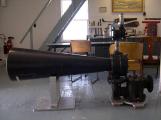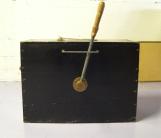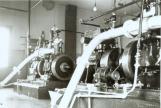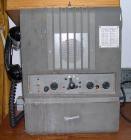33
Engine and compressor for fog alarm.1930
Point Atkinson, West Vancouver, British Columbia, Canada
 Credits:
Credits:Courtesy of Dave Grafton.
34
As Don Graham recounts in his history of British Columbia keepers, the new foghorn added more cleaning duties to the roster of keeper's responsibilities:"Once a month he had to open the boiler, crawl into its damp innards, hammer off any deposits on the walls, and hose it out. When the plant was in operation he was compelled to stay inside, in that ear-splitting din of hissing steam and flapping belts, with the bellowing horn rattling tools on their racks. Erwin could be relieved 'for meals &c' only by another competent hand. When thick weather finally cleared (in 1896 he logged 1450 hours of it), he had to shut the plant down, rub down all the machinery, sweep up coal dust, dump clinkers out of the grates, then polish lubricators, flywheel rims, and all the other brass work before locking the doors and trudging up to the house to watch for more fog. In clear weather he packed sacks of coal and hauled water for the boiler. In February 1897 Erwin exhausted his annual coal supply and began cutting trees for fuel. All too often it was an exercise in frustration when the fog stopped by long enough to exhaust his entire supply of split kindling, then capriciously moved on."
35
Derrick for delivering coal to power the fog alarm.1936
Point Atkinson, West Vancouver, British Columbia, Canada
 Credits:
Credits:Courtesy of Norm Dawe.
36
Laurence Grafton remembers using the fog horn:The industrial area on False Creek was a curse because the smog would drift out at across English Bay. The midnight boat to Victoria would come out…. When you lost sight of English bay, you were on the watch and the horn had to be on. You had no way of telling how severe it was, whether it was fog, or whether it was smog or what it was…. You had to start the engines and get the compressors going. Invariably, you had your compressed air in the big tank. Dad used to go up when the ships would start blowing their whistles. He would go up and give it a manual blast before we got the engines going. The tank was probably about twelve feet high and eight feet around…. I remember one summer with fire, smoke, forest fires. We had nine days and nights operating the foghorn. And those old engines, I'll tell you, they were pretty tough.
37
Fog horn at Point Atkinson Lighthouse.2004
Point Atkinson, West Vancouver, British Columbia, Canada

39
Norm Dawe remembers:When it was foggy, visibility under three miles, then the horn would have to be put in operation…well you had to start the engines up, depending whether you were using one of them or two of them. The original Fairbanks were six horse Fairbanks, single cylinder jobs. They were connected with belt drives to compressors, which compressed the air in a big tank. This tank would have been maybe ten to twelve feet high, diameter [would be] six to seven feet. You build up your air pressure, around thirty pounds and then you start the timer on the horn and that was just belt-driven mechanical type of thing, when the wheel went around it had a little lump on it and when the little lump hit the valve it would open and let the air through and continue on. Your engines had to be tended. They were not sophisticated engines. They had drip-type lubricant.
40
Front of manual fog horn at Point Atkinson Lighthouse.2004
Point Atkinson, West Vancouver, British Columbia, Canada

41
Side of manual fog horn used at Point Atkinson Lighthouse.2004
Point Atkinson, West Vancouver, British Columbia, Canada

42
Petters diesel engines.1950
Point Atkinson, West Vancouver, British Columbia, Canada
 Credits:
Credits:Courtesy of Norm Dawe
43
Norm Dawe remembers:Whatever you could fix, you would fix it yourself. It was very seldom that you actually brought in help…. Like with the old gas engines, they were forever throwing bearings, so you would have strip your engine down and actually pour a new bearing. In this day and age, this is just unheard of; you would just get a replacement. You would get one engine running again and then the other … would break down, so during the foggy season, it was pretty much continuous. They weren't the most reliable. In those days too, there was a lot more fog than there is today. You can't judge the fog today with say in the '30s. There were beehive burners all over the place: every home in Vancouver, Victoria, Nanaimo. They were all heated with coal, wood, sawdust. All those particles go into the air and little bit of moisture and then you would have fog. And there would be fog solid for a week…fall, spring, summer…
44
Air chimes replaced the diaphone foghorn in 1974. The air chimes were two horns, one for the long note, which was followed by a shorter blast at a lower pitch. An automatic fog-detecting device called a videograph triggered them. The fog alarm system was discontinued in 1997, when the light was automated.45
RadiosPoint Atkinson was outfitted with a radio beacon in 1935. Radios used for navigation rely on the principle of triangulation. An automatic signal was sent out at regular intervals and in foggy weather; it was synchronized with the foghorn. Like the foghorn, the radio beacon was removed in 1996, when the lighthouse was automated.

